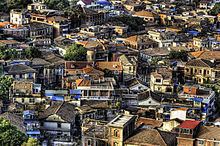Simplified Chinese 鼓浪屿 Hokkien POJ Kó͘-lōng-sū Literal meaning Drum Wave Islet Province Fujian | Traditional Chinese 鼓浪嶼 Postal Kulangsu Hanyu Pinyin | |
 | ||
Similar South Putuo Temple, Fujian Tulou, Shuzhuang Garden (East Gat, Kinmen, Hulishan Cannon Fort | ||
Gulangyu is the third largest island off the coast of Xiamen, a city in Fujian Province in southern China. It is about 2 km2 (0.77 sq mi) in area. It is home to about 20,000 people and is a domestic tourist destination. The only vehicles permitted are small electric buggies and electric government service vehicles.
Contents
- Map of Gulangyu Siming Xiamen China 361000
- The International Settlement
- Awards
- Attractions
- Transportation
- Cultural communication
- References
Map of Gulangyu, Siming, Xiamen, China, 361000
Visitors can reach it by ferry from the ferry terminal in Xiamen. Local residents are allowed to use a shorter 5 minute ferry to/from Heping Ferry Terminal. Tourists and non-locals must now take a longer 20 minute ferry ride from Dongdu International Terminal, as of October 20, 2014 with a fare increase from 8 yuan to 35 yuan. This has been in order to reduce tourist numbers accessing the island in an effort to conserve it. In addition to the ferry tickets, you can book a scenic entrance fees package for 100 yuan to 5 places of attraction, named as A, B, C, D and E (these are attraction locations and not optional routes). Note that at the Dongdu International Terminal you can only book to travel on the day and your passport is required for foreigners.
Gulangyu Island is renowned for its beaches and winding lanes and its varied architecture. The island is on China's list of National Scenic Spots and also ranks at the top of the list of the ten most-scenic areas in the province.
Administratively, the island presently forms Gulangyu Subdistrict of Xiamen's Siming District.
The International Settlement
For a time, Gulangyu had the peculiarity of having constituted the only international settlement on Chinese soil apart from the more celebrated International Settlement at Shanghai.
Soon after Xiamen became a treaty port resulting from China's loss in the First Opium War and the Treaty of Nanking in 1842, foreign residents on the island established an informal organization that became formally organized several decades later when its Land Regulations were approved by the government of China in May 1902. Eventually 13 countries, including Great Britain, France, The Netherlands and Japan, were to enjoy extraterritorial privileges there and take part in the Kulangsu Municipal Council that administered the settlement. As with the Shanghai International Settlement, the British played a predominant role in the administration and Sikh policemen from British India were charged with the policing of the Settlement. The consulates, churches, hospitals, schools, police stations, etc. built by those foreign communities explain the predominantly Victorian-era style architecture that can still be seen throughout Gulangyu. Japanese occupation of the island began in 1942, and lasted until the end of World War II. The Hokkien dialect is spoken on the island, as it is in Xiamen.
Awards
- In 2005, Gulangyu Island was rewarded as the most beautiful district of China by Chinese National Geography magazine.
- On May 2007, Xiamen Gulangyu Island was officially proved as the National 5A Tourist Attractions by the National Tourism Administration of China.
Attractions
As a place of residence for Westerners during Xiamen's colonial past, Gulangyu is famous for its architecture and for hosting China's only piano museum, giving it the nickname of "Piano Island" or "The Town of Pianos" (鋼琴之鄉) or "The Island of Music" (音樂之島). There are over 200 pianos on this island.
The Chinese name also has musical roots, as 鼓浪 Kó͘-lōng which means drum waves so-called because of the sound generated by the ocean waves hitting the reefs. 嶼 sū means "islet".
In addition, there is a museum dedicated to Koxinga, Hai-toe Se-kai (海底世界) Marine World, a subtropical garden containing plants introduced by overseas Chinese, as well as Xiamen Museum, formerly the Eight Diagrams Tower (八卦樓).
The island of Gulangyu is a pedestrian-only destination, where the only vehicles on the islands are several fire trucks and electric tourist buggies. The narrow streets on the island, together with the architecture of various styles around the world, give the island a unique appearance. The site is classified as a AAAAA scenic area by the China National Tourism Administration.
Transportation
Gulangyu is unique in China as a "traffic-free island". It is connected to the main island of Xiamen only by ferry.
Neither cars nor bicycles are allowed, thus providing an alternative to the frenetic Xiamen Island across the river, although the recent introduction of electric tourist buggies may be damaging the island's charm. Freight is pulled on wheeled wooden carts up the often steep lanes by strong teams of men.
Cultural communication
The spread of Christianity in 1900s brought western music to the island. Churches and museums were built, and people enjoyed going to music halls to hear performances. Since then, Gulanyu Island's local cultural environment mingled with introduced foreign music and art, which is why Gulangyu cultural scene differs from other parts of China. Many notable musicians were born in that time, such as Shu'an Zhou, Junji Lin, and Zuohuang Chen. Gulangyu's piano ownership per capita ranks the first in nation, and by 2002, Gulangyu Island was given the name of "The Island of Music" by Chinese Musicians' Association. The piano exhibition halls and museums and overall artistic atmosphere attract many musicians domestically and internationally.
